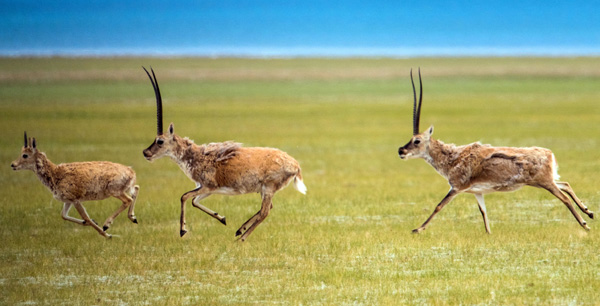
Tibetan antelopes cross grasslands at Nagqu prefecture in the Tibet autonomous region. The species' population has risen to 250,000, leading to a downgrading of its level of protection. (Photo/Xinhua)
The rebound in numbers of the once-endangered Tibetan antelope has come with some unintended consequences, a conservation official said on Wednesday.
While the species' survival is more assured now, its growing numbers also have put some pressure on fragile mountain grasslands.
The antelope population had declined to about 70,000 in the early 1990s from poaching, but it has reached about 250,000 nationwide, including 150,000 in the Tibet autonomous region, according to a report by the Chinese Academy of Sciences released on Wednesday.
The antelope was downgraded last month from "endangered" to "near threatened", dropping two levels, at the sixth World Conservation Congress of the International Union for Conservation of Nature in Honolulu, Hawaii.
"On one hand, certainly, it is good to see the protection measures are effective," said Yan Xun, a senior wildlife conservation official with the State Forestry Administration. "But on the other, we've received some reports that the animals have done damage to grasslands in some areas."
The damage has not been acute enough to suggest the antelope population should be controlled, Yan said.
The population, which reached almost 1 million a century ago, was in harmony with nature. Now, some habitat has been occupied by people and thus the antelope are more concentrated in certain areas, putting pressure on grasslands, he said.
An academy report based on a three-year study said the ecosystem of the Tibetan plateau has been stable over the past 20 years, although grasslands have decreased by 0.13 percent.
Wang Xiaodan, who co-authored the report, said rehabilitation techniques for degraded grasslands are not well developed and the terrain and climate of the plateau pose extra challenges.
Other challenges remain: Reports show the population of black-necked crane, or Tibetan crane, is 7,000. There are about 10,000 Tibetan yaks, and the Tibetan red deer number 1,000.


















































